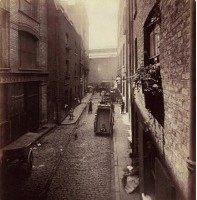
I’ve had a street photography-infused couple of days: Hoppé yesterday and at the Museum of London today. But then, 2011 has been dubbed the Year of Street Photography, so it isn’t all that surprising. The Museum of London is contributing to this with its exhibition of over 200 street photos shot in London, dating from 1860 to 2010, which opens tomorrow. Almost all of the pictures have come from the museum’s own archives, and they form an intriguing story for both the city of London and the evolution of street photography.

Admiralty Arch on the day before Queen Elizabeth II’s coronation, 1 June 1953, Bob Collins, © Estate of Bob Collins, courtesy Museum of London
I suppose that I would say that, though. In another life, before I found myself writing about all things photographic, I studied and taught history. Bring together history and photography and you have me in my element. Still, using objectivity was something that I got to practise lots back in my days immersed in Tacitus, so I’d best dust it off now.
When you look at the exhibition as a history of the evolution of photography, you get to see images taken on tripod-mounted glass plate cameras through to mobile phone snaps, via everything from the first hand-held cameras to stereoscopes. So not only do you get to see how photographic styles have changed over the years – you start with Victorian pictorialism and move through modernism in all its forms, the influence of cinema and of European immigrants, and even touch on photojournalism – but you get to see how technology has an influence on what gets photographed and how.
Those glass plate long-exposures couldn’t capture cleanly anything that was moving; so you either have someone definitely posed, or a haze of ghostly motion, and often a bit of both. When smaller, hand-held cameras became available there was an explosion in candid, concealed shots: photographers hid their kit in brown paper bags! You get to see how artificial light changed the look and the subject of photos, and how smaller, lighter cameras have made street photography that bit more spontaneous.
At the very core of this exhibition, though, are London’s inhabitants; young and old, rich and poor, native and immigrant. You get to see the relationship between the city and the people who live in it, and how both have changed.
Of course, people are what street photography is all about. You get to see them when a camera was a curiosity right through to now, when so often it feels as if a camera is something to be feared. In fact, it’s sad to see how few children feature in the later images. Their increasing absence is documentary evidence of the altering attitudes to photography and privacy.
Historians and photographers alike are going to get something out of this exhibition, but somehow I think that the biggest winner could be photography itself. The exhibition conveys just how important photos are to documenting our lives and our history.
The next time that I hear that tiresome refrain: ‘You can’t take photos here!’ I’d really like to pack off the myopic shrieker to take a look at this exhibition. Maybe, just maybe, they’d pick up just how much of today will be lost to tomorrow without the help of the camera and the skill of the photographer.
London Street Photography runs from 18 February to 4 September 2011 at the Museum of London, 150 London Wall, London, EC2Y 5HN.
(Featured image: Bishops Court, City of London 1882, Arthur Eason, © Museum of London.)







